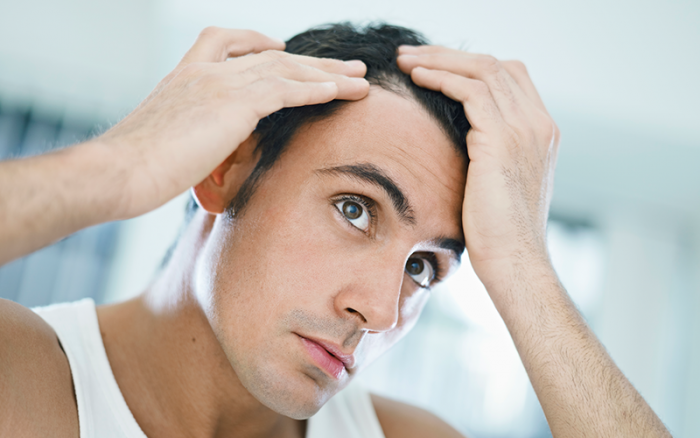Does your hair and scalp always feel dirty or greasy even after you have just washed your hair? You may be suffering from oily scalp, a skin disorder that can cause dandruff, or maybe a more serious skin disorder called seborrheic dermatitis.
An oily scalp is caused by an excess amount of sebum, the skin’s natural oils. Why is your scalp producing too much sebum? It could be genetic or hormonal, or it could be because of a specific condition called seborrheic dermatitis.
If you have an oily scalp, dandruff, waxy hair or symptoms of seborrheic dermatitis, what should you do? What are the best treatments for oily scalp?
Solutions for Oily Scalp
To reduce the amount of sebum that your scalp produces, it is important to keep your scalp healthy and clean. Wash your hair every day, making sure to rinse well to clear any product buildup, and use a medicated dandruff shampoo. Also, try taking a break from styling products that can cause build-up on the scalp, including leave-in conditioners, hairsprays, and oils.
Over-the-counter medicated dandruff shampoos have active ingredients that can clean your scalp and reduce the overall oiliness and buildup of dead skin cells.
“Try brushing any crusty patches from your scalp and letting the dandruff shampoo sit on your scalp for several minutes before rinsing it out so that it has more time to treat the area,” says Dr. Ross Reule of U.S. Dermatology Partners Shoal Creek. “There are many good over-the-counter medicated shampoos with active ingredients to clear your scalp of oil, buildup, and dandruff.”
Natural, at-home remedies such as rinsing your hair with apple cider vinegar can remove the buildup of styling products. Adding a few drops of tea tree oil to your shampoo or massaging it directly on your scalp can also help reduce oiliness.
If over-the-counter treatments aren’t doing the trick, or your oily scalp is causing symptoms of seborrheic dermatitis, you should call your dermatologist. Sometimes the condition is a symptom of a more serious underlying medical problem.
What Is Seborrheic Dermatitis?
Seborrheic dermatitis is a common skin disease in infants, as well as in adults. In babies, this condition is called “cradle cap” and appears as scaly, greasy patches on the scalp that can become thick and crusty. The condition is harmless and typically clears up on its own within the first year of a baby’s life.
In adults, seborrheic dermatitis has similar symptoms, but it is longer lasting. Flare-ups can occur throughout an individual’s lifetime and can be triggered by factors such as cold weather or stress. Adults suffering from seborrheic dermatitis can have scaly, itchy patches anywhere on the body, including the scalp. The patches often look greasy, and when the scales flake off, they take the form of yellowish or white dandruff.
Seborrheic dermatitis is not caused by poor hygiene, it is not the result of an allergic reaction and it is generally harmless. The exact causes are unknown, though it is thought to be related to a specific yeast or fungus in the oil secretion on the skin called Malassezia or an atypical response of the immune system.
Individuals with HIV, acne, rosacea, psoriasis, Parkinson’s disease, epilepsy, alcoholism, depression or eating disorders seem to be at a greater risk for developing the condition, and some medications — such as Interferon, Lithium, and Psoralen — have been known to increase the risk of seborrheic dermatitis.
Related: What’s the Difference Between Actinic Keratosis and Seborrheic Keratosis?
Treatments for Seborrheic Dermatitis
There is no cure for seborrheic dermatitis — and the condition will not usually go away on its own in adults — but there are many treatments to remove the scales, alleviate the symptoms and prevent a more serious skin infection.
Dandruff shampoos typically provide relief from the burning and itching caused by seborrheic dermatitis. When using dandruff shampoo, make sure to follow the directions on the bottle, as some shampoos should be left on the scalp for several minutes.
Different dandruff shampoos have different active ingredients. If one does not provide relief, try another with an alternate active ingredient. If symptoms persist, a dermatologist can prescribe stronger ointments and crèmes to use on your scalp.
Prescription-strength corticosteroids can be applied to the scalp and are generally effective but should be used sparingly because of possible side effects. Sometimes, your doctor may recommend the use of an antifungal gel, crème or shampoo with another medication. If other treatments are not effective, an antifungal medication in pill form is can be prescribed.
“Effectively controlling seborrheic dermatitis may require trying several different treatments or a combination of medications and treatments,” says Dr. Reule. “Work with your dermatologist to find the solution that works best for you.”
Looking to Visit a Dermatologist for an Oily Scalp?
If your oily scalp is causing you embarrassment or you have stubborn dandruff that isn’t responding to over-the-counter treatments — or if you think you may be suffering from seborrheic dermatitis — contact U.S. Dermatology Partners today for a consultation with one of our board-certified dermatologists. We have multiple locations throughout the country, so fill out our simple online form to get in touch with us. One of our local team members will reach out to you shortly to answer your questions or schedule an appointment for you to visit us soon.
Find a location near me
or

